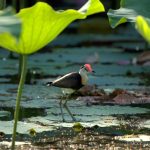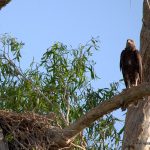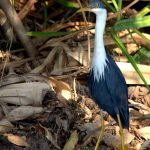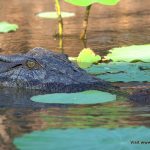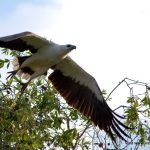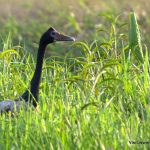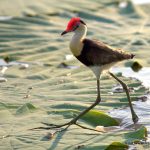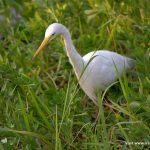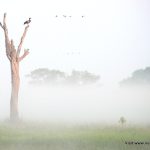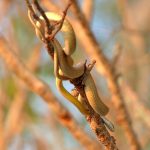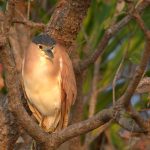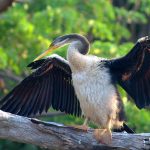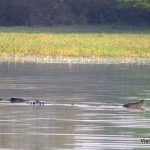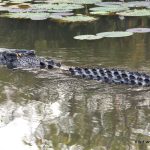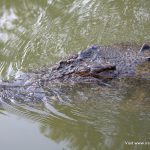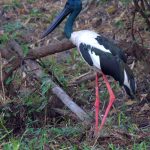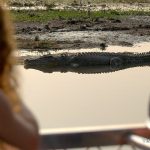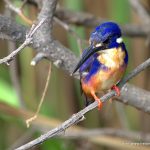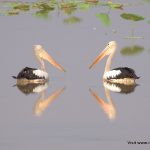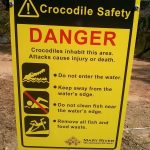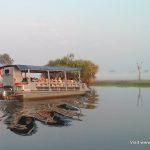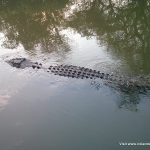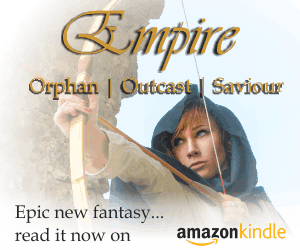
Awe, tempered with a healthy dose of apprehension. That’s the only way to describe a close encounter with a large saltwater crocodile (Crocodylus porosus).
Saltwater or estuarine crocodiles, or plain old “Salties” as they’re called in local vernacular, are the largest reptile species on earth, with males routinely exceeding 4 metres in length, and some specimens reaching an incredible 6.5 metres or more, and weighing up to a massive 2,000 Kg.
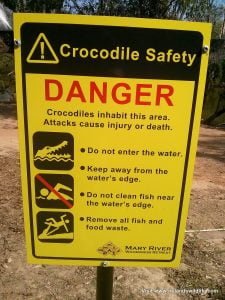
Australia’s Northern Territory harbours the highest concentration of saltwater crocodiles anywhere in the world, making it a poor choice for swimmers, but one of the best place to see this incredible animal up-close and personal.
Large crocs eat pretty much anything they can catch — including fish, birds and large mammals like kangaroos, wallabies, feral pigs, water buffalo, and even people if the opportunity presents itself. Just a few weeks before we arrived in the Northern Territory an angler was taken by a large crocodile on the Adelaide river. The hapless fisherman had waded into the shallows to untangle his line when the croc — a large albino male dubbed “Michael Jackson” by the locals — struck. All his wife could do was watch helplessly from the bank.
Crocodiles are one of the most dangerous animals on earth, and warrant a healthy respect, but as long as you stay out of the water, and don’t venture too close to the edge, you’re safe enough. Despite… or perhaps because of that element of danger… crocodiles are undoubtedly one of the wildlife highlights of Australia’s Top End, and you don’t have to venture far from the NT’s capital, Darwin, for great close encounters with these impressive reptiles in their natural habitat.
The NT: it’s not all about crocodiles

While crocs are the undisputed masters of the Northern Territory’s waterways, the state’s remarkable wetland systems support an incredibly diversity of wildlife. From iconic wetland birds like the comb-crested jacana, the black-necked stork (AKA the Australian Jabiru) and the stately Brolga crane, to snakes, lizards, fish and an astonishing variety of invertebrates, everywhere you look there’s something else to see.
When we visited in mid September it was approaching the end of the dry season. As smaller waterways dry out much of the wildlife in the region is forced to concentrate at the relatively few permanent waterways left. That concentration of wildlife makes for some superb wildlife watching opportunities.
Choose a natural Northern Territory wetland tour
Crocodiles feature prominently on the Northern Territory tourist scene, but if, like me, you’re more interested in seeing wildlife doing what comes naturally, rather than the spectacular but unnatural “taught” behaviour designed to give tourists a thrill, then you’ll probably want to steer clear of the many “jumping crocodile” cruises along the Adelaide river.
Instead, look for a cruise that’s more wildlife focused, without the hype and hoopla. That’s exactly what you get with the two cruises we were lucky enough to try: the Corroboree Billabong Wetland Cruises and Yellow Waters Cruises.
Corroboree Billabong: wonderful wetland wildlife on Darwin’s doorstep

If you’re looking for a fantastic Northern Territory wildlife experience that’s an easy day trip out of Darwin, then the Corroboree Billabong Wetland Cruise is the ideal choice.
Part of the fabled Mary River Wetlands, home to the largest concentration of saltwater crocodiles in the world, Corroboree Billabong is just 100km from Darwin, making it well within reach for a day-trip. They offer a 1 hour morning cruise, a 2.5 hour lunchtime cruise (which includes lunch) and a 1.5 hour sunset cruise. They also offer a “day-trip” package that includes the lunchtime cruise and pick-up and drop-off at your Darwin accommodation to accommodate those without transport — you’ll find full details here.
While the day trip / lunchtime cruise offers the longest time on the water, the best times for wildlife are early morning or evening, so we opted for the sunset cruise.
The location is an easy drive down the Arnhem Highway out of Darwin in the direction of Kakadu National Park. It takes about 1 to 1 1/4 hours (depending on whether or not you get caught behind a road-train on the way) to reach the Corroboree park tavern, then a further 21 km down to Corroboree Billabong, the last 10km on an unsealed road.
NB. If you don’t want to drive your vehicle on the unsealed road (or are unable to — as in the case of most non-4WD rental vehicles) the company operates a shuttle service from the Corroboree Park Tavern for AU$5 return per person. The shuttle leaves 30 minutes before the scheduled cruise departure and you need to book in advance if you’d like to use it.
For more information about the Corroboree Billabong Wetland Cruise check the FAQ page on their website.
Our mission is to provide visitors with the best wildlife experience the top end has to offer as they enjoy a cruise on our spectacular wetlands.
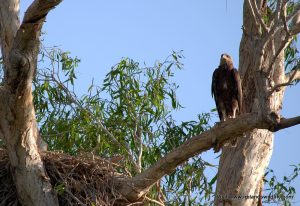
When we arrived at the billabong our wetland cruise guide, Jim, showed us to the boat. It was a custom-built shallow-draft vessel with a metal hull, perfect for cruising the shallow waters of the billabong and getting in close to wildlife near the banks. One of the great things about the boat was that it got you down almost to water level, offering superb panoramic views of the billabong and its wildlife, and some wonderful photo opportunities.
As we slipped away from the dock into the billabong proper, Jim explained a little bit about the habitat and some of the wildlife we might see on the trip. It wasn’t long before we started to spot some of the birds and beasts Jim mentioned: a pair of comb-crested jacanas sauntering across the lily pads on huge feet, a young white-bellied sea eagle close to its nest, and a little further down the billabong its vigilant parents looking on, jabirus on the floodplains adjacent to the billabong and magpie geese flying overhead.

We saw two species of whistling duck, rajah shell-duck and green pygmy goose; we saw kingfishers, egrets and herons; there were Australian darters and of course there were crocodiles… plenty of crocodiles. Over the course of the cruise we encountered maybe a dozen crocs in all, almost all of them salties, but we were very lucky to spot one of the much smaller freshwater crocodile hauled out on the bank: a rare treat amidst its monstrous cousins.
With such an abundance of wildlife to see the 1.5 hour cruise simply flew by. Jim’s commentary was superb, explaining not just what we were seeing, but also offering insight into the unique ecosystem of the top-end wetlands and the species that call it home.
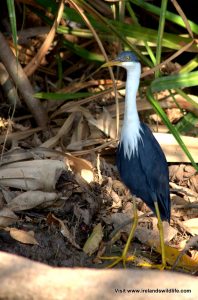
All too soon we were back at the dock after a truly memorable trip. As a self-confessed wildlife nut I was always going to be happy “in amongst it” on the water, but perhaps the biggest testament to just how enjoyable the Corroboree Billabong experience was is the fact that my two thirteen-year-old daughters and their 11-year-old sister, who appreciate wildlife, but are in no way obsessed by it like I am, were equally fascinated.
I’d certainly recommend the trip for anyone interested in wildlife, including families, and anyone looking for the real-deal “top-end” wildlife experience conveniently near Darwin.
Yellow Water Cruises: an iconic Kakadu wetland extravaganza
Around 170km south east of Darwin, Kakadu National Park is a world renowned wildlife hotspot famous for the extensive wetlands associated with the Alligator River system. The park spans just under 200km north to south, and more than 100km east to west, making it just a little smaller than Ireland’s largest province, Munster.
No wildlife trip to the Northern Territory would be complete without a visit to Kakadu, and there’s no better way to experience Kakadu’s iconic wetland wildlife than on a wetland cruise.
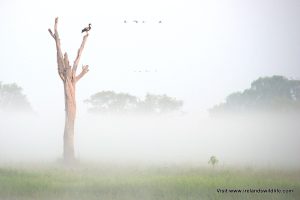
Yellow Water Cruises is part of the indigenously owned Gagudju Dreaming company based in Cooinda, deep in the heart of Kakadu. The company offers a variety of cruises on the famous Yellow Water Billabong. This permanent wetland sits at the end of Jim-Jim creek, a tributary of the South Alligator River. I chose to join them on their popular 06:45 sunrise cruise, mainly because the early morning is one of the best times to see wildlife, but I won’t deny that the included buffet breakfast back at Cooinda Lodge after the cruise may have had a bearing on my decision.
A free shuttle bus from Cooinda Lodge takes you on the short five minute drive to the billabong. When we arrived it was immediately apparent that this was a much bigger and more commercial operation than what we’d experienced at Corroboree Billabong. There we’d had the wetland to ourselves, here there were three Yellow Water Cruise boats and a Yellow Water fishing charter all departing at the same time. The cruise boats were slightly larger versions of the shallow-draft, metal-hulled craft used at Corroboree. They are very comfortable, offer an excellent all-round view and are ideal for cruising the billabong.

There was a bit of a delay leaving the dock as we waited for several pre-booked tour groups to arrive and make their way aboard. That wasn’t as bad as it sounds, because sitting on the boat offered a great view of the early morning mist rolling across the wetlands as the sun broke the horizon. Magpie geese flew overhead, their distinctive silhouettes easy to identify, an osprey surveyed the scene from its lofty vantage point and an Australian darter dried its wings nearby.
Once everyone was aboard we headed off down the billabong, and as the boats dispersed any worries I had that the waterways might be a bit congested dissipated. Our guide, Belinda, offered informative commentary not just on the wildlife we saw on the trip, but also on the wetland ecosystem, and its significance to the indigenous people who own the land.

Kakadu is famous for its bird life. The park is home to more than 280 bird species, around a third of all the birds recorded in Australia. It was no surprise to find birds featuring prominently on the cruise. Whistling duck and magpie geese were everywhere, often accompanied by rajah shellduck and green pygmy geese. Herons were also common, and we soon notched up four species of egret (great, intermediate, little, and cattle), along with pied–heron, white-faced heron, white-necked heron and the nankeen or rufous night-heron. Comb-crested jacanas patrolled the lily pads around the billabong edge, while black-winged stilts hunted in the shallows. Jabiru (black-necked stork) and brolgas stalked through the longer vegetation of the flood plains, where water buffalo and feral ponies also roamed. Australian pelicans gathered on deeper pools as whiskered terns flapped buoyantly overhead. Raptors included the aforementioned osprey, whistling kite and the majestic white-bellied sea eagle. We were also lucky enough to see three species of kingfisher, including the dainty little azure kingfisher at close quarters, which was a real treat.
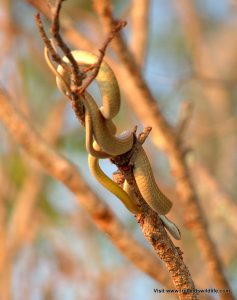
One of the highlights of the cruise for me was spotting an exquisite golden tree snake soaking up the early morning sun at the end of a slender branch. The snake was fantastic, but for most people aboard it was another reptile that stole the show: the salties were out in force.
We must have encountered at least twenty crocodiles during the two-hour cruise, and were treated to a range of behaviour including some rarely seen crocodile courtship, and a large (4.5 metre plus) male croc cruising within a few feet of the boat. Crocodiles spend a lot of their time sitting motionless, and to see any activity is always a bonus. This was exceptional.
All too soon it was time to head back to the dock, leaving the billabong and its wildlife behind — but at least there was breakfast to look forward to. Early morning wildlife watching can be hungry work.
If you are heading to the Northern Territory as part of your trip “down-under” I’d heartily recommend doing one, or even both of these cruises. Although similar in some ways, the two billabongs offer very different experiences, and are both well worth a visit.
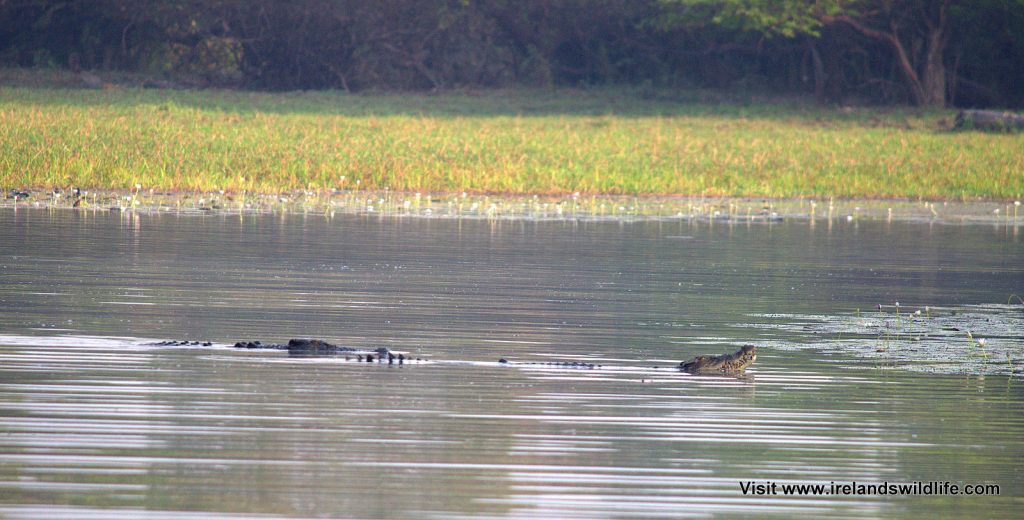
Check out the slideshow below for more photos, and don’t forget to let us know what you think in the comments.
I’d like to thank Corroboree Wetland Cruises and Yellow Water Cruises for their hospitality on their respective tours. For more information on either of the cruises featured here, or to book your tickets, please contact Corroboree Billabong Wetland Cruises and Yellow Water Cruises directly.


